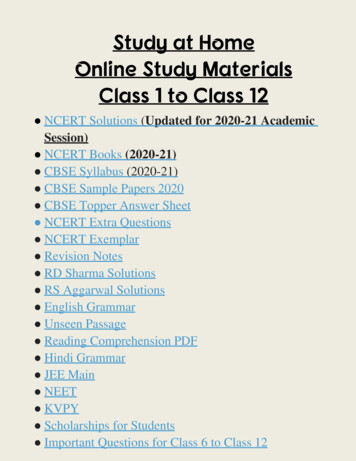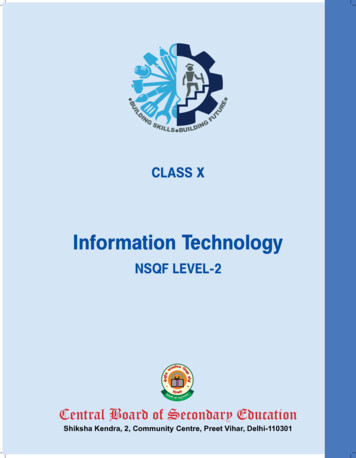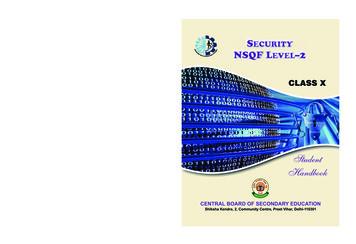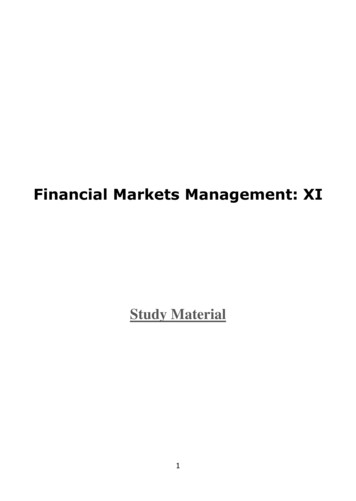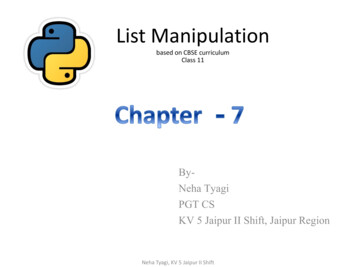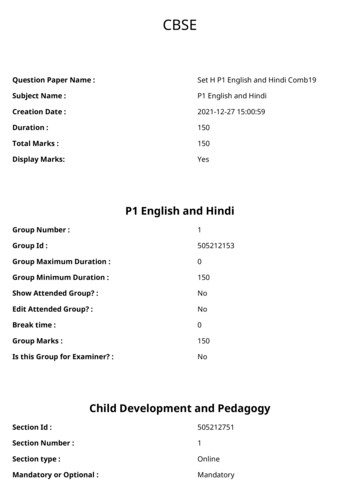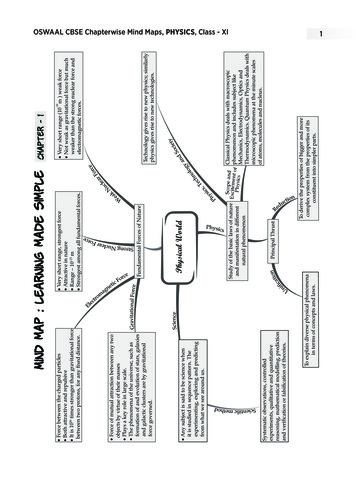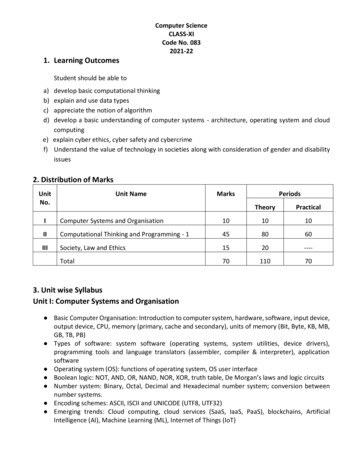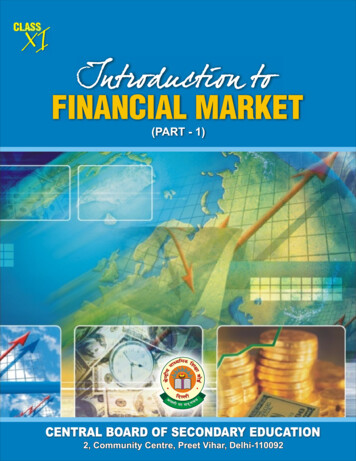
Transcription
LEARNING OBJECTIVESAfter studying this chapter, you will be able:l To understand the financial markets.l To understand various alternative financial instruments.l To compare alternative financial instruments on key parameters.l To know various investment objectives and constraints of the financial instruments.l To understand the difference between real investments and financial investments.We had the opportunity to watch the action from the ring side seat – and the thingswe saw, heard and experienced stirred some deeper thoughts in our mind about ourwisdom or lack of it, in matters related to financial markets and money.Many investors in spite of distressing evidence all around still get carried away by hype.Financial business is all about informed decisions. We realize that discerning data ifnot readily available in one place can make it difficult for anyone to choose intelligently.In an effort to capture the diverse issues of financial markets in a single summary, weshare our experiences; views and insights in this chapter.You have heard about the heart rendering stories of how people were driven to destitutionwhen they lost all their money in reckless investments. You may have also been captivatedby tales of how some others vaulted to indecent riches through the same process. Thischapter tries to discourage you from adopting a similar approach to investments. Instead,it suggests that an early and habitual flow of savings if invested prudently can makemillionaires out of common men. A disciplined and cautious approach to wealth managementrewards you in more ways than one.Financial markets are full of imperfections, which make results inconsistent with the expectations.Genuine conditions apart, in the present world of finance, human greed, system failuresor national afflictions can make things very unpredictable. This is where risk comes intoplay. This chapter deals in sufficient details, the different manifestations of risk in eachasset class and tries to suggest you the ways to minimize it.Many of us have one simple approach to dealing with risk. That is to avoid it by allmeans. In financial investment matters, this may not be a good strategy. As risk andreturn are correlated, every risk you are avoiding possibly deprives you of a handsomeopportunity to build your wealth. Balancing risk with return in line with your individualcircumstances is what financial market management is all about? This chapter throwssome light on these simple but mostly neglected aspects of managing one’s own finance.1
1.1 Types of MarketsEfficient transfer of resources from those having idle resources to others who have apressing need for them is achieved through financial markets. Stated formally, financialmarkets provide channels for allocation of savings to investment. These provide a varietyof assets to savers as well as various forms in which the investors can raise funds andthereby decouple the acts of saving and investment. The savers and investors are constrainednot by their individual abilities, but by the economy’s ability, to invest and save respectively.The financial markets, thus, contribute to economic development to the extent thatthe latter depends on the rates of savings and investment.The financial markets have two major components:l Money marketl Capital market.The Money market refers to the market where borrowers and lenders exchange shortterm funds to solve their liquidity needs. Money market instruments are generally financialclaims that have low default risk, maturities under one year and high marketability.The Capital market is a market for financial investments that are direct or indirect claimsto capital. It is wider than the Securities Market and embraces all forms of lending andborrowing, whether or not evidenced by the creation of a negotiable financial instrument.The Capital Market comprises the complex of institutions and mechanisms through whichintermediate term funds and long-term funds are pooled and made available to business,government and individuals. The Capital Market also encompasses the process by whichsecurities already outstanding are transferred.The Securities Market, however, refers to the markets for those financial instruments/claims/obligations that are commonly and readily transferable by sale.The Securities Market has two interdependent and inseparable segments, the new issues(primary) market and the stock (secondary) market.The Primary market provides the channel for sale of new securities. The issuer of securitiessells the securities in the primary market to raise funds for investment and/or to dischargesome obligation.The Secondary market deals in securities previously issued. The secondary market enablesthose who hold securities to adjust their holdings in response to charges in their assessmentof risk and return. They also sell securities for cash to meet their liquidity needs.The price signals, which subsume all information about the issuer and his business includingassociated risk, generated in the secondary market, help the primary market in allocationof funds.2
This secondary market has further two components.First, the spot market where securities are traded for immediate delivery and payment.The other is forward market where the securities are traded for future delivery andpayment. This forward market is further divided into Futures and Options Market (DerivativesMarkets).In futures Market the securities are traded for conditional future delivery whereas inoption market, two types of options are traded. A put option gives right but not anobligation to the owner to sell a security to the writer of the option at a predeterminedprice before a certain date, while a call option gives right but not an obligation tothe buyer to purchase a security from the writer of the option at a particular pricebefore a certain date.Lets now understand these markets in broader sense.1.2 Equity MarketBefore discussing the equities market, we should first understand the basic meaningof markets, their functions and classification.1.2.1 What is a Market?A market is a location where buyers and sellers come into contact to exchange goodsor services. Markets can exist in various forms depending on various factors.1.2.2 Can Markets Exist in Different Forms?Yes, the markets do exist in different forms depending on the nature of location andmode of contact. It can have a physical location where buyers and sellers come indirect contact with each other or a virtual location where the buyers and sellers contact3
each other employing advance means of communication. There is another form of marketwhere actual buyers and sellers achieve their objectives through intermediaries.1.2.3 Securities Markets in India: An OverviewThe process of economic reforms and liberalization was set in motion in the mid-eightiesand its pace was accelerated in 1991 when the economy suffered severely from a precariouslylow foreign exchange reserve, burgeoning imbalance on the external account, decliningindustrial production, galloping inflation and a rising fiscal deficit. The economic reforms,being an integrated process, included deregulation of industry, liberalization in foreigninvestment, regime, restructuring and liberalization of trade, exchange rate, and tax policies,partial disinvestments of government holding in public sector companies and financialsector reforms. The reforms in the real sectors such as trade, industry and fiscal policywere initiated first in order to create the necessary macroeconomic stability for launchingfinancial sector reforms, which sought to improve the functioning of banking and financialinstitutions (FIs) and strengthen money and capital markets including securities market.The securities market reforms specifically included: Repeal of the Capital Issues (Control) Act, 1947 through which Government usedto expropriate and allocate resources from capital market for favored uses; Enactment of the Securities and Exchange Board of India Act, 1992 to provide forthe establishment of the Securities and Exchange Board of India (SEBI) to regulateand promote development of securities market; Setting up of NSE in 1993, passing of the Depositories Act, 1996 to provide forthe maintenance and transfer of ownership of securities in book entry form; Amendments to the Securities Contracts (Regulation) Act, 1956 (SCRA) in 1999 toprovide for the introduction of futures and option. Other measures included free pricing of securities, investor protection measures,use of information technology, dematerialization of securities, improvement in tradingpractices, evolution of an efficient and transparent regulatory framework, emergenceof several innovative financial products and services and specialized FIs etc.These reforms are aimed at creating efficient and competitive securities market subjectto effective regulation by SEBI, which would ensure investor protection.1.2.4 A Profile4The corporate securities market in India dates back to the 18th century when the securitiesof the East India Company were traded in Mumbai and Kolkotta. The brokers used togather under a Banyan tree in Mumbai and under a Neem tree in Kolkata for the purposeof trading those securities. However the real beginning came in the 1850’s with theintroduction of joint stock companies with limited liability. The 1860’s witnessed feverishdealings in securities and reckless speculation. This brought brokers in Mumbai together
in July 1875 to form the first formally organized stock exchange in the country viz. TheStock Exchange, Mumbai. Ahmedabad stock exchange in 1894 and 22 others followedthis in the 20th century. The process of reforms has led to a pace of growth almostunparalleled in the history of any country. Securities market in India has grown exponentiallyas measured in terms of amount raised from the market, number of stock exchangesand other intermediaries, the number of listed stocks, market capitalization, tradingvolumes and turnover on stock exchanges, investor population and price indices. Alongwith this, the profiles of the investors, issuers and intermediaries have changed significantly.The market has witnessed fundamental institutional changes resulting in drastic reductionin transaction costs and significant improvements in efficiency, transparency and safety,thanks to the National Stock Exchange. Indian market is now comparable to many developedmarkets in terms of a number of parameters.1.2.5 Structure and Size of the MarketsToday India has two national exchanges, the Bombay Stock Exchange (BSE) and the NationalStock Exchange (NSE). Each has fully electronic trading platforms with around 9400 participatingbroking outfits. Foreign brokers account for 29 of these. There are some 9600 companieslisted on the respective exchanges with a combined market capitalization near Rs.24.7lakh crore. Any market that has experienced this sort of growth has an equally substantialdemand for highly efficient settlement procedures. In India 99.9% of the trades, accordingto the National Securities Depository, are settled in dematerialized form in a T 2 rollingsettlement The capital market is one environment. In addition, the National SecuritiesClearing Corporation of India Ltd (NSCCL) and Bank of India Shareholding Ltd (BOISL),Clearing Corporation houses of NSE and BSE, guarantee trades respectively. The mainfunctions of the Clearing Corporation are to work out (a) what counter parties oweand (b) what counter parties are due to receive on the settlement date.Furthermore, each exchange has a Settlement Guarantee Fund to meet with any unpredictablesituation and a negligible trade failure of 0.003%. The Clearing Corporation of the exchangesassumes the counter-party risk of each member and guarantees settlement through afine-tuned risk management system and an innovative method of online position monitoring.It also ensures the financial settlement of trades on the appointed day and time irrespectiveof default by members to deliver the required funds and/or securities with the helpof a settlement guarantee fund.1.2.6 Style of OperatingIndian stock markets operated in the age-old conventional style of fact-to-face tradingwith bids and offers being made by open outcry. At the Bombay Stock Exchange, about3,000 persons would mill around in the trading ring during the trading period of twohours from 12.00 noon to 2.00 p.m. Indian stock markets basically quote-driven marketswith the jobbers standing at specific locations in the trading ring called trading postsand announcing continuously the two-way quotes for the scrips traded at the post.As there is no prohibition on a jobber acting as a broker and vice versa, any member5
is free to do jobbing on any day. In actual practice, however, a class of jobbers hasemerged who generally confine their activities to jobbing only. As there are no seriousregulations governing the activities of jobbers, the jobbing system is beset with a numberof problems like wide spreads between bid and offer; particularly in thinly traded securities,lack of depth, total absence of jobbers in a large number of securities, etc. In highlyvolatile scrips, however, the spread is by far the narrowest in the world being just about0.1 to 0.25 percent as compared to about 1.25 per cent in respect of alpha stocks,i.e. the most highly liquid stocks, at the International Stock Exchange of London. Thespreads widen as liquidity decreases, being as much as 25 to 30 per cent or evenmore while the average touch of gamma stocks, i.e. the least liquid stocks at the InternationalStock Exchange, London, is just about 6 to 7 per cent. This is basically because of thehigh velocity of transactions in the active scrips. In fact, shares in the specified groupaccount for over 75 percent of trading in the Indian stock markets while over 25 percentof the securities do not get traded at all in any year. Yet, it is significant to note thatout of about 6,000 securities listed on the Bombay Stock Exchange, about 1,200 securitiesget traded on any given trading day.The question of automating trading has always been under the active considerationof the Bombay Stock Exchange for quite sometime. It has decided to have trading inall the non-specified stocks numbering about 4,100 totally on the computer on a quotedriven basis with the jobbers, both registered and roving, continuously keying in theirbids and offers into the computer with the market orders getting automatically executedat the touch and the limit orders getting executed at exactly the rate specified.In March 1995, the BSE started the computerized trading system, called BOLT - BSEon-line trading system. Initially only 818 scripts were covered under BOLT. In July 1995,all scripts (more than 5,000) were brought under the computerized trading system.The advantages realized are: (a) improved trading volume; (b) reduced spread betweenthe buy-sell orders; c) better trading in odd lot shares, rights issues etc.1.2.7 Highlights of the Highly Attractive Indian Equity MarketTwo major reasons why Indian securities are now increasingly regarded as attractiveto international investors are the relatively high returns compared with more developedglobal markets as well as the low correlation with world markets.1.3 Debt Market6The National Stock Exchange started its trading operations in June 1994 by enablingthe Wholesale Debt Market (WDM) segment of the Exchange. This segment providesa trading platform for a wide range of fixed income securities that includes centralgovernment securities, treasury bills (T-bills), state development loans (SDLs), bondsissued by public sector undertakings (PSUs), floating rate bonds (FRBs), zero couponbonds (ZCBs), index bonds, commercial papers (CPs), certificates of deposit (CDs), corporatedebentures, SLR and non-SLR bonds issued by financial institutions (FIs), bonds issuedby foreign institutions and units of mutual funds (MFs).
To further encourage wider participation of all classes of investors, including the retailinvestors, the Retail Debt Market segment (RDM) was launched on January 16, 2003.This segment provides for a nation wide, anonymous, order driven, screen based tradingsystem in government securities. In the first phase, all outstanding and newly issuedcentral government securities were traded in the retail debt market segment. Othersecurities like state government securities, T-bills etc. will be added in subsequent phases.The settlement cycle is same as in the case of equity market i.e., T 2 rolling settlementcycle.1.4 Derivatives MarketThe emergence of the market for derivative products, most notably forwards, futuresand options, can be traced back to the willingness of risk-averse economic agents toguard themselves against uncertainties arising out of fluctuations in asset prices. By theirvery nature, the financial markets are marked by a very high degree of volatility. Throughthe use of derivative products, it is possible to partially or fully transfer price risks bylocking–in asset prices. As instruments of risk management, these generally do not influencethe fluctuations in the underlying asset prices.However, by locking-in asset prices, derivative products minimize the impact of fluctuationsin asset prices on the profitability and cash flow situation of risk-averse investors.1.4.1 Derivatives DefinedDerivative is a product whose value is derived from the value of one or more basicvariables, called bases (underlying asset, index, or reference rate), in a contractual manner.The underlying asset can be equity, forex, commodity or any other asset. For example,wheat farmers may wish to sell their harvest at a future date to eliminate the risk ofa change in prices by that date. Such a transaction is an example of a derivative. Theprice of this derivative is driven by the spot price of wheat which is the “underlying”.In the Indian context the Securities Contracts (Regulation) Act, 1956 (SC(R)A) defines“derivative” to include – A security derived from a debt instrument, share, loan whether secured or unsecured,risk instrument or contract for differences or any other form of security. A contract, which derives its value from the prices, or index of prices, of underlyingsecurities.Derivatives are securities under the SC(R)A and hence the trading of derivatives is governedby the regulatory framework under the SC(R)A.1.4.2 Products, Participants and FunctionsDerivative contracts have several variants. The most common variants are forwards, futures,options and swaps. The following three broad categories of participants - hedgers,7
speculators, and arbitrageurs trade in the derivatives market. Hedgers face risk associatedwith the price of an asset. They use futures or options markets to reduce or eliminatethis risk. Speculators wish to bet on future movements in the price of an asset. Futuresand options contracts can give them an extra leverage; that is, they can increase boththe potential gains and potential losses in a speculative venture. Arbitrageurs are inbusiness to take advantage of a discrepancy between prices in two different markets.If, for example, they see the futures price of an asset getting out of line with the cashprice, they will take offsetting positions in the two markets to lock in a profit.The derivatives market performs a number of economic functions. First, prices in anorganized derivatives market reflect the perception of market participants about thefuture and lead the prices of underlying to the perceived future level. The prices ofderivatives converge with the prices of the underlying at the expiration of the derivativecontract. Thus derivatives help in discovery of future as well as current prices. Second,the derivatives market helps to transfer risks from those who have them but may notlike them to those who have an appetite for them. Third, derivatives, due to their inherentnature, are linked to the underlying cash markets. With the introduction of derivatives,the underlying market witnesses higher trading volumes because of participation by moreplayers who would not otherwise participate for lack of an arrangement to transferrisk. Fourth, speculative trades shift to a more controlled environment of derivativesmarket. In the absence of an organized derivatives market, speculators trade in theunderlying cash markets. Margining, monitoring and surveillance of the activities of variousparticipants become extremely difficult in these kind of mixed markets. Fifth, an importantincidental benefit that flows from derivatives trading is that it acts as a catalyst for newentrepreneurial activity. The derivatives have a history of attracting many bright, creative,well-educated people with an entrepreneurial attitude. They often energize others tocreate new businesses, new products and new employment opportunities, the benefitof which are immense. Finally, derivatives markets help increase savings and investmentin the long run. Transfer of risk enables market participants to expand their volume ofactivity.1.4.3 Types of DerivativesThe most commonly used derivatives contracts are forwards, futures and options, whichwe shall discuss these in detail in the FMM-II later. Here we take a brief look at variousderivatives contracts that have come to be used.8 Forwards: A forward contract is a customized contract between two entities, wheresettlement takes place on a specific date in the future at today’s pre-agreed price. Futures: A futures contract is an agreement between two parties to buy or sell anasset at a certain time in the future at a certain price. Futures contracts are specialtypes of forward contracts in the sense that the former are standardized exchangetraded contracts. Options: Options are of two types - calls and puts. Calls give the buyer the right
but not the obligation to buy a given quantity of the underlying asset, at a givenprice on or before a given future date. Puts give the buyer the right, but not theobligation to sell a given quantity of the underlying asset at a given price on orbefore a given date. Warrants: Options generally have lives of up to one year, the majority of optionstraded on options exchanges having a maximum maturity of nine months. Longerdated options are called warrants and are generally traded over-the-counter. LEAPS: The acronym LEAPS means Long-Term Equity Anticipation Securities. Theseare options having a maturity of up to three years. Baskets: Basket options are options on portfolios of underlying assets. The underlyingasset is usually a moving average or a basket of assets. Equity index options area form of basket options. Swaps: Swaps are private agreements between two parties to exchange cash flowsin the future according to a prearranged formula. They can be regarded as portfoliosof forward contracts. The two commonly used swaps are:Interest rate swaps: These entail swapping only the interest related cash flows betweenthe parties in the same currency andCurrency swaps: These entail swapping both principal and interest between the parties,with the cash flows in one direction being in a different currency than those in theopposite direction. Swaptions: Swaptions are options to buy or sell a swap that will become operativeat the expiry of the options. Thus a swaption is an option on a forward swap. Ratherthan have calls and puts, the swaptions market has receiver swaptions and payerswaptions. A receiver swaption is an option to receive fixed and pay floating. Apayer swaption is an option to pay fixed and receive floating.1.5 Commodities MarketDerivatives as a tool for managing risk first originated in the commodities markets. Theywere then found useful as a hedging tool in financial markets as well. In India, tradingin commodity futures has been in existence from the nineteenth century with organizedtrading in cotton through the establishment of Cotton Trade Association in 1875. Overa period of time, other commodities were permitted to be traded in futures exchanges.Regulatory constraints in 1960s resulted in virtual dismantling of the commodities futuremarkets. It is only in the last decade that commodity future exchanges have been activelyencouraged. However, the markets have been thin with poor liquidity and have notgrown to any significant level. Let’s look at how commodity derivatives differ from financialderivatives.9
1.5.1 Difference between Commodity and Financial DerivativesThe basic concept of a derivative contract remains the same whether the underlyinghappens to be a commodity or a financial asset. However there are some features,which are very peculiar to commodity derivative markets. In the case of financial derivatives,most of these contracts are cash settled. Even in the case of physical settlement, financialassets are not bulky and do not need special facility for storage. Due to the bulky natureof the underlying assets, physical settlement in commodity derivatives creates the needfor warehousing. Similarly, the concept of varying quality of asset does not really existas far as financial underlying is concerned. However in the case of commodities, thequality of the asset underlying a contract can vary largely. This becomes an importantissue to be managed. We have a brief look at these issues.Physical Settlement: Physical settlement involves the physical delivery of the underlyingcommodity, typically at an accredited warehouse. The seller intending to make deliverywould have to take the commodities to the designated warehouse and the buyer intendingto take delivery would have to go to the designated warehouse and pick up the commodity.This may sound simple, but the physical settlement of commodities is a complex process.The issues faced in physical settlement are enormous. There are limits on storage facilitiesin different states. There are restrictions on interstate movement of commodities. Besidesstate level octroi and duties have an impact on the cost of movement of goods acrosslocations.Warehousing: One of the main differences between financial and commodity derivativesis the need for warehousing. In case of most exchange traded financial derivatives,all the positions are cash settled. Cash settlement involves paying up the differencein prices between the time the contract was entered into and the time the contractwas closed. For instance, if a trader buys futures on a stock at Rs.100 and on the dayof expiration, the futures on that stock close Rs.120, he does not really have to buythe underlying stock. All he does is take the difference of Rs.20 in cash. Similarly theperson, who sold this futures contract at Rs.100, does not have to deliver the underlyingstock. All he has to do is pay up the loss of Rs.20 in cash. In case of commodity derivativeshowever, there is a possibility of physical settlement. Which means that if the sellerchooses to hand over the commodity instead of the difference in cash, the buyer musttake physical delivery of the underlying asset. This requires the exchange to make anarrangement with warehouses to handle the settlements. The efficacy of the commoditiessettlements depends on the warehousing system available. Most international commodityexchanges used certified warehouses (CWH) for the purpose of handling physical settlements.Such CWH are required to provide storage facilities for participants in the commoditiesmarkets and to certify the quantity and quality of the underlying commodity. The advantageof this system is that a warehouse receipt becomes a good collateral, not just for settlementof exchange trades but also for other purposes too. In India, the warehousing systemis not as efficient as it is in some of the other developed markets. Central and stategovernment controlled warehouses are the major providers of agri-produce storagefacilities. Apart from these, there are a few private warehousing being maintained. However10
there is no clear regulatory oversight of warehousing services.Quality of Underlying Assets: A derivatives contract is written on a given underlying.Variance in quality is not an issue in case of financial derivatives as the physical attributeis missing. When the underlying asset is a commodity, the quality of the underlying assetis of prime importance. There may be quite some variation in the quality of what isavailable in the marketplace. When the asset is specified, it is therefore important thatthe exchange stipulate the grade or grades of the commodity that are acceptable. Commodityderivatives demand good standards and quality assurance/certification procedures. Agood grading system allows commodities to be traded by specification.Currently there are various agencies that are responsible for specifying grades for commodities.For example, the Bureau of Indian Standards (BIS) under Ministry of Consumer Affairsspecifies standards for processed agricultural commodities whereas AGMARK under thedepartment of rural development under Ministry of Agriculture is responsible for promulgatingstandards for basic agricultural commodities. Apart from these, there are other agencieslike EIA, which specify standards for export oriented commodities.1.6 Meaning and Features of Private, Public CompaniesThe principal forms of business organization whose securities are traded in the FinancialMarkets in India are Companies – both public and private.Companies incorporated in India and branches of foreign corporations are regulatedby the Companies Act, 1956 (the Act). The Act, which has been enacted to overseethe functioning of companies in India, draws heavily from the United Kingdom’s CompaniesActs and although similar, is more comprehensive. The Registrar of Companies (ROC)and the Company Law Board (CLB), both working under the Department of CompanyAffairs, ensure compliance with the Act.1.6.1 Types of CompaniesA company can be a public or a private company and could have limited or unlimitedliability. A company can be limited by shares
The Securities Market has two interdependent and inseparable segments, the new issues (primary) market and the stock (secondary) market. The Primary market provides the channel for sale of new securities. The issuer of securities sells the securities in the primary market to raise funds for investment and/or to discharge some obligation.
